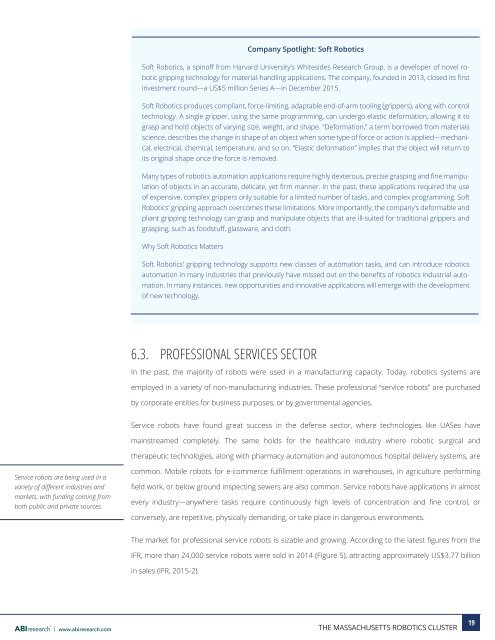ROBOTICS CLUSTER
Massachusetts%20Robotics%20Cluster%20Report%20Final
Massachusetts%20Robotics%20Cluster%20Report%20Final
Create successful ePaper yourself
Turn your PDF publications into a flip-book with our unique Google optimized e-Paper software.
Company Spotlight: Soft Robotics<br />
Soft Robotics, a spinoff from Harvard University’s Whitesides Research Group, is a developer of novel robotic<br />
gripping technology for material-handling applications. The company, founded in 2013, closed its first<br />
investment round—a US$5 million Series A—in December 2015.<br />
Soft Robotics produces compliant, force-limiting, adaptable end-of-arm tooling (grippers), along with control<br />
technology. A single gripper, using the same programming, can undergo elastic deformation, allowing it to<br />
grasp and hold objects of varying size, weight, and shape. “Deformation,” a term borrowed from materials<br />
science, describes the change in shape of an object when some type of force or action is applied—mechanical,<br />
electrical, chemical, temperature, and so on. “Elastic deformation” implies that the object will return to<br />
its original shape once the force is removed.<br />
Many types of robotics automation applications require highly dexterous, precise grasping and fine manipulation<br />
of objects in an accurate, delicate, yet firm manner. In the past, these applications required the use<br />
of expensive, complex grippers only suitable for a limited number of tasks, and complex programming. Soft<br />
Robotics’ gripping approach overcomes these limitations. More importantly, the company’s deformable and<br />
pliant gripping technology can grasp and manipulate objects that are ill-suited for traditional grippers and<br />
grasping, such as foodstuff, glassware, and cloth.<br />
Why Soft Robotics Matters<br />
Soft Robotics’ gripping technology supports new classes of automation tasks, and can introduce robotics<br />
automation in many industries that previously have missed out on the benefits of robotics industrial automation.<br />
In many instances, new opportunities and innovative applications will emerge with the development<br />
of new technology.<br />
6.3. PROFESSIONAL SERVICES SECTOR<br />
In the past, the majority of robots were used in a manufacturing capacity. Today, robotics systems are<br />
employed in a variety of non-manufacturing industries. These professional “service robots” are purchased<br />
by corporate entities for business purposes, or by governmental agencies.<br />
Service robots have found great success in the defense sector, where technologies like UASes have<br />
mainstreamed completely. The same holds for the healthcare industry where robotic surgical and<br />
therapeutic technologies, along with pharmacy automation and autonomous hospital delivery systems, are<br />
Service robots are being used in a<br />
variety of different industries and<br />
markets, with funding coming from<br />
both public and private sources.<br />
common. Mobile robots for e-commerce fulfillment operations in warehouses, in agriculture performing<br />
field work, or below ground inspecting sewers are also common. Service robots have applications in almost<br />
every industry—anywhere tasks require continuously high levels of concentration and fine control, or<br />
conversely, are repetitive, physically demanding, or take place in dangerous environments.<br />
The market for professional service robots is sizable and growing. According to the latest figures from the<br />
IFR, more than 24,000 service robots were sold in 2014 (Figure 5), attracting approximately US$3.77 billion<br />
in sales (IFR, 2015-2).<br />
www.abiresearch.com<br />
THE MASSACHUSETTS <strong>ROBOTICS</strong> <strong>CLUSTER</strong><br />
19


